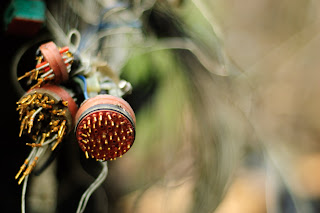The first thing that we noticed in Leh was the eerie silence there, (and I am not talking about spiritual silence @ 11,000 feet, kind of thing) the silence of the official machinery on China was baffling. Chinese incursions into India were making national headlines – but Ajit Kumar Sahu the Deputy Commissioner of Leh assured me that some ‘isolated instances were being blown out of proportion by the media’. But if that was the case – why did the same Mr. Sahu shoot off a letter to the government, confirming repeated incursions by the Chinese? Why was it that the man who had blown the whistle on the Chinese incursions had suddenly become so nonchalant???
Within twenty-four hours of us landing in Leh one thing was clear– there was an unofficial gag order in circulation – over any mention of the border dispute. After initial news of Chinese incursions and rock paintings leaked out from the Ladakh sector – the local administration had surely been censured. When our cameras weren’t even allowed in the offices of the Deputy Commissioner, SSP and the ITBP – we knew that something was amiss. The only option for us then was to see for ourselves what was happening along the Sino-India border.
Pangong Tso (Tso: Ladakhi for lake) would have been a tourist haven had it not been geographically situated along an intensely disputed territory. At an astounding altitude of 13,900 ft, the 134 km long lake extends from India to China along the Line of Actual Control, 60% of the length of the lake is controlled by China – the rest is with India. The six hours that it took us to reach Pangong from Leh explained the need for India to accelerate its border highway project. While China has built double width paved roads, right upto the border – we are still to make all weather roads even between major transit points. As our car pitched and rolled on unpaved roads we saw something more astounding along our way… hundreds of army trucks were moving to and fro from the advanced border posts – old military bases being spruced up and new military check posts being set up – even filed guns had been positioned at specific locations, their barrels pointing towards China. (see pic) So even as SM Krishna was reassuring the nation that the border with China was ‘most peaceful’ the army was taking no chances, ensuring that another Kargil does not happen. (China sure does have the inclination and the military might to embark on such an adventure)
We stopped for tea at Changla Pass (the world’s third – highest pass) and here our ‘papers’ were checked. (An Inner Line Permit is required, even for Indians, to visit the lake as it lies on the Sino-Indian Line of Actual Control) When we quizzed a jawan about the heavy deployment of men and machines at the border with China, we got a standard monosyllabic answer, ‘Exercise’
It was late in the noon when we finally made it to the Pangong Lake, the breathtaking views aside – you realize the strategic importance of the lake – for you can see Chinese territory from here. It was a chance meeting with (Retd.) Company Major Hawaldar Wanchoo here – that proved to be an eye opener. A veteran of the Kargil war, Wanchoo quit the Indian Army in 2000 to start is own little resort. But the locals still flock to him and tell him what they have spotted on the Chinese side.
The government of Jammu and Kashmir has admitted to it only now, but the locals have been telling Wanchoo for months, that the Chinese have been nibbling away at Indian territory – inch by inch and not by yards. First the shepherds are shooed away (sometimes harassed) when they take their sheep out to graze along the border…then Chinese troops indulge in ‘aggressive patrolling’ and finally China quietly constructs permanent structures in otherwise
disputed/Indian territory. Along the Pangong lake itself – the Chinese enter Indian territory as many as five times a week! Not only that – the so called ‘no man’s land’ between the two nations has virtually disappeared with the Chinese walking right upto the Indian observation posts.
So is the media crying horse over nothing? Empirical data suggests that we better tighten our belts, pull up our socks and wear our reading glasses to understand the new ‘great game’ that is afoot.
FACT – China wants to keep India engaged in talks, even as it continues to build military pressure in the area. Talks have been going on for three decades –with no breakthrough, is proof enough
FACT – China is consolidating its national power (with special focus on Tibet region), once that is done, expect more pressure on the LAC with India
FACT – the military muscle mismatch between the two countries is wide and is increasing day by day … China and NOT Pakistan is a more potent threat
FACT – Long before we lost Askai Chin in ’62 – there had been reports of Chinese activity in the area…from ’57 onwards India chose to ignore the clear signals of Chinese aggression.
Whatever the Foreign Minister or the Army says – these are historical facts that can’t be dismissed; facts that point out that China is again eying Indian Territory (even though they are moving forward at a glacial pace). The question is – will India stand around like a dinosaur or respond to the climatic change – for even a class five student will tell you that failure to adapt to the changing situation – can result in annihilation.





